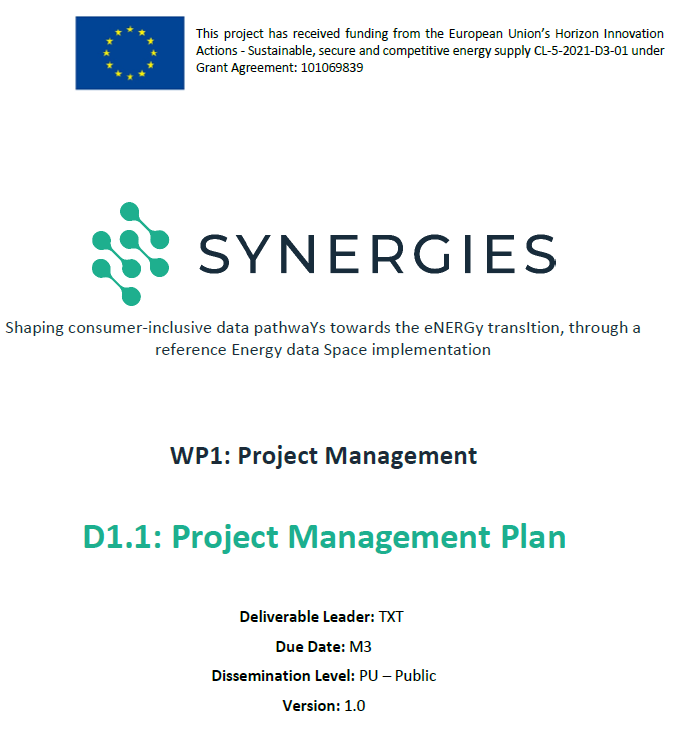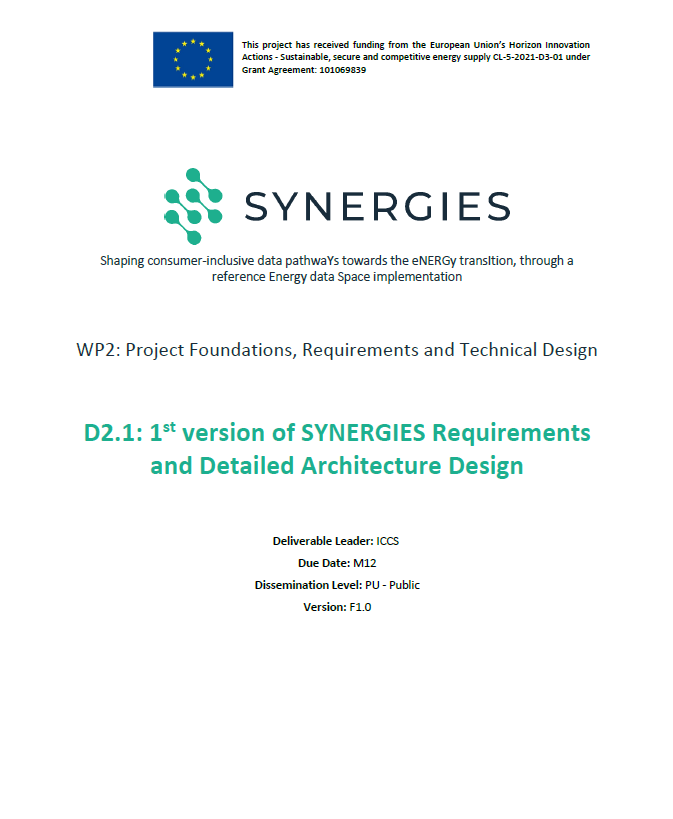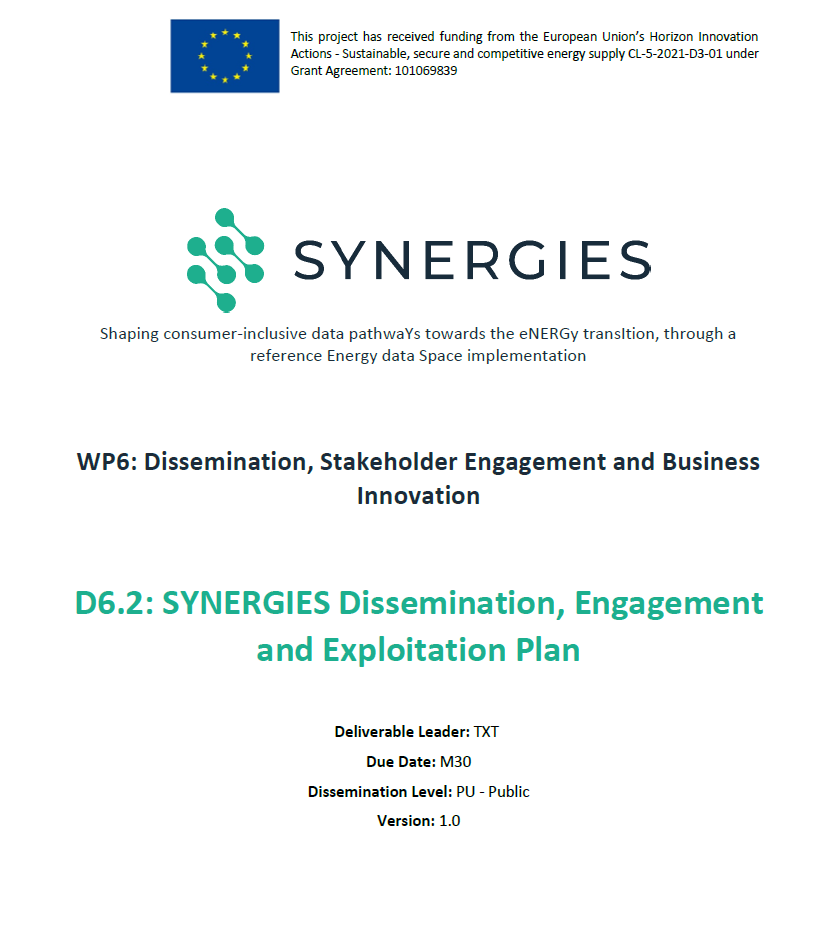
D1.1 “Project Management Plan” describes the processes and tools that are applied in the SYNERGIES project to ensure high-quality of the SYNERGIES deliverables and of the overall project management activities. The document identifies the structure, processes, timeline and tools that shape the project organisation and work. The quality assurance process has been defined, including standard procedures to create the project documents and periodical reporting to tackle potential deviations. Moreover, a set of tools has been developed to ensure optimal internal communication and coordination. In addition, the risk management methodology has been described in detail and is accompanied by the initial Risk Registry and Contingency Plan.
Special attention has been granted to the ethical approach and the IPR management, given the strong data-relevant nature of SYNERGIES, in order to ensure a smooth management of the SYNERGIES Energy Data Spaces.

D6.1 “Dissemination, Communication and Engagement Plan” defines the baseline strategy and guidelines for creating a context where SYNERGIES research dissemination and communication can be maximised. In detail, this document provides the objectives, the key messages, the project’s target audience and the channels to be used. Moreover, the dissemination and communication plan is presented with road maps and expected outcomes for the two project periods (M1-M20; M21-M42). The description of online presence and media is reported as well as communication materials, events planning for collaboration of the project with other projects and initiatives, news and publications schedule. In addition to these topics, the stakeholders’ engagement strategy through Living Lab organisation is included, providing a preliminary planning. Finally, an overview on the actual status of foreseen activities is reported, comprising: the release of the project website; set up of the social media channel and development of the project identity, including the presentations template; the start of collaboration with the sister projects and other European R&I initiatives; media communications announcing the project launch.

D1.2 “1Data Management Plan” describes the management policies for the data that will be collected, processed and/or generated by the SYNERGIES project. It takes into account the existing European Commission’s guidelines on Open Science, in particular Open Access to Research Data1 by adopting the FAIR principles methodology. Therefore, as part of making the research data Findable, Accessible, Interoperable and Re-Usable (FAIR), the DMP will include information on:
(i) handling of research data during & after the project (use and re-use of data);
(ii) what data will be collected, processed and/or generated;
(iii) which methodology & standards will be applied;
(iv) whether data will be shared/made open access;
(v) and how data will be curated & preserved, including ethical aspects.

D2.1 “1st version of SYNERGIES Requirements and Detailed Architecture Design” presents the concept of SYNERGIES. More specifically, it provides a detailed report on the activities related to the definition of the concept of SYNERGIES, the Use Cases of the novel technological solutions that will be developed, the technical requirements that are necessary for the development of these solutions, the regulatory and socioeconomic barriers on the adoption of these novel technologies, the overall architecture of SYNERGIES and the, finally, Minimum Viable Product (MVP) for the project.

D3.1 “SYNERGIES Energy Data Space Release 1.00” accompanies and documents the software release of the initial version of the SYNERGIES Reference Energy Data Space on Month 18 of the SYNERGIES project. The first part of the deliverable acts as a reference for the work progress which delivers the Data Interoperability and Governance Block, the Data Security and Sovereignty Block, the Trusted Data Sharing Block, the Data Value Accrual Block, and the Backbone SYNERGIES Data Space Infrastructure accordingly, until Month 18. For each building block, a structured documentation is provided, giving an overview of the underlying functionalities, a short description of the implementation status per identified feature, the technologies used in the development of this block, the assumptions and restrictions, and the features which are planned for the final release; such features have been either partially implemented in the draft release and are going to be enhanced in the final release, or shall be built altogether in the final release.
In its second part, the deliverable outlines the SYNERGIES platform experience (that is fully documented online in the Help menu), making a reference to the structure and main menus of the SYNERGIES Reference Energy Data Space that are visible for all users: Data Check-In, Data Monitoring, My Assets, Marketplace, Contracts, Data Retrieval, and Data Space Management. Furthermore, the integration approach followed during the software delivery cycles is described in detail, and the adopted support channels are presented.
Finally, D3.1 presents the SYNERGIES Sectorial Data Models in Annex II. There are four SYNERGIES Sectorial Data Models, which model the Energy, Building and EV domains and cover the General concepts, that are common across all domains.

D7.1 “Intermediate Report on Interoperability Demonstration and Liaison activities” comprises a report on the preliminary activities performed in collaboration with sister projects towards the definition of Fundamental Requirements for a common European Energy Data Space, the validation of Energy Data Spaces Integration and Interoperable Data Exchange and the interactions performed with relevant initiatives and existing data platforms/datahubs.

Deliverable 6.2 “SYNERGIES Dissemination, Engagement and Exploitation Plan” comprises an update of dissemination, communication and engagement activities, as well as their planning, a preliminary overview of the exploitation strategy for the SYNERGIES Energy Data Space and individual KERs and a first version of the SYNERGIES business models will be included, in preparation for their assessment during demo activities.
